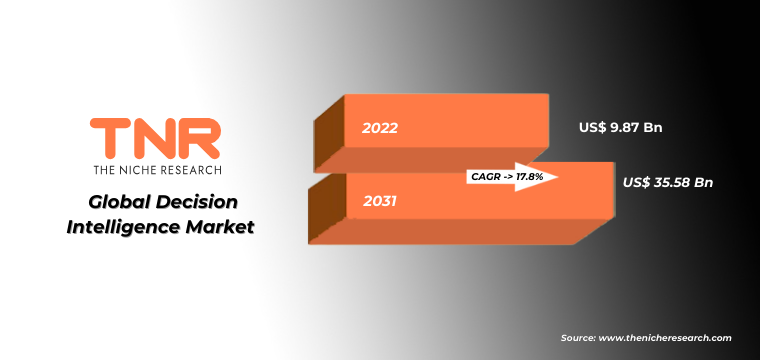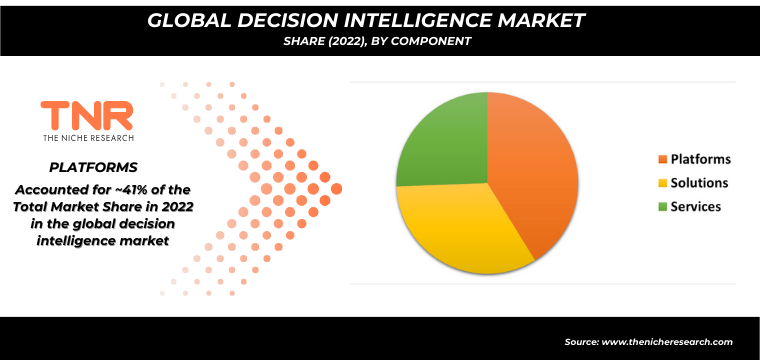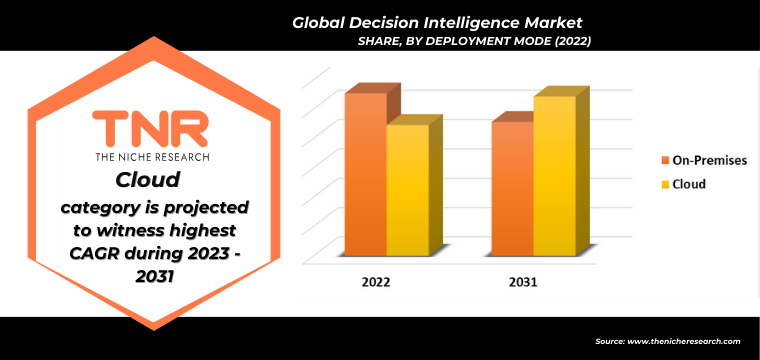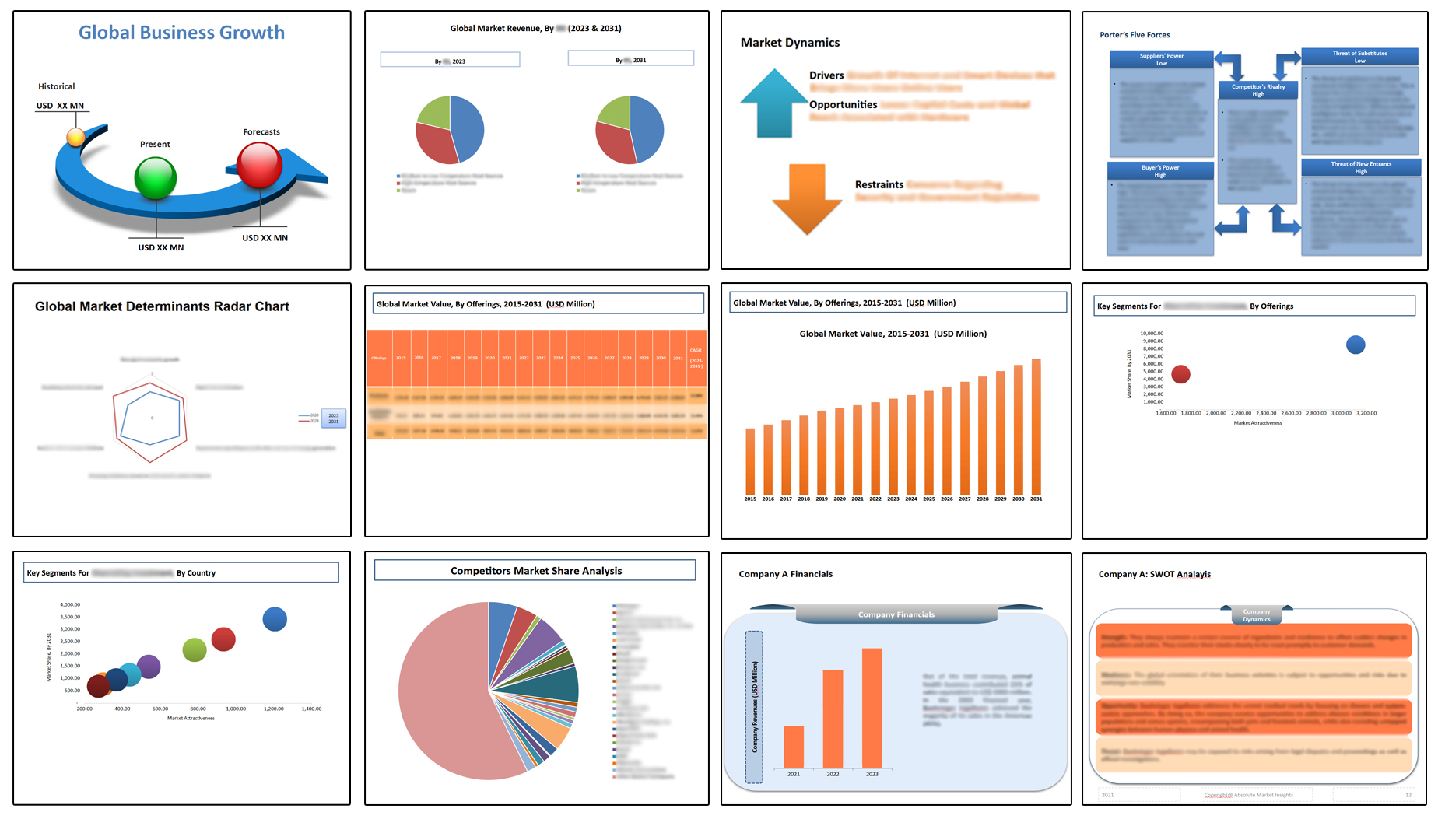Global Decision Intelligence Market By Component, By Deployment Mode, By Organization Size, By Industry Vertical, By Region: Global Insights, Growth, Size, Comparative Analysis, Trends and Forecast, 2023 – 2031
- Industry: Technology
- Report ID: TNR-110-987
- Number of Pages: 420
- Table/Charts : Yes
- November, 2023
- Base Year : 2024
- No. of Companies : 10+
- No. of Countries : 29
- Views : 10226
- Covid Impact Covered: Yes
- War Impact Covered: Yes
- Formats : PDF, Excel, PPT
Global Decision Intelligence Market Recorded Revenue Worth US$ 9.87 Billion in 2022, Growing at an Estimated CAGR of 17.8% from 2023-2031.
Decision Intelligence refers to the integration of data analysis, artificial intelligence, and human decision-making processes to enhance choices. It combines insights from various sources, enabling informed decisions. By leveraging advanced analytics and AI, organizations optimize outcomes, streamline operations, and adapt strategies in dynamic environments for better overall results.
Cloud deployment is growing at the highest rate in the decision intelligence market. With businesses increasingly embracing digital transformation, cloud solutions provide agility and accessibility. A Forbes report stated that 83% of enterprise workloads were in the cloud in 2021. This growth reflects the shift toward cloud-based decision intelligence solutions that cater to evolving business needs and changing market dynamics.
Global Decision Intelligence Market Revenue & Forecast, (US$ Million), 2015 – 2031

COVID-19 Impact Analysis on Global Decision Intelligence Market
Before the pandemic, the decision intelligence market was steadily evolving, driven by advancements in analytics and AI. Organizations recognized its potential to enhance decision-making across sectors, from finance to healthcare, optimizing operations and outcomes. The COVID-19 pandemic amplified the need for agile decision-making. The crisis underscored decision intelligence’s significance in adapting strategies swiftly. Remote work, supply chain disruptions, and changing consumer behaviors highlighted its role in navigating uncertainties. Organizations increasingly relied on data-driven insights to make informed choices, solidifying decision intelligence’s pivotal role in the post-pandemic landscape.

The exponential growth of data acts as a major driver in the decision intelligence market. IBM’s report highlighted that 2.5 quintillion bytes of data are generated daily. As data becomes more diverse and voluminous, decision intelligence solutions are crucial for extracting actionable insights. Data gathered has revealed that 92.2% of executives believe their organizations struggle to manage data. This driver underscores the necessity of advanced analytics and AI-driven tools to harness data’s potential for informed decision-making. Data privacy concerns pose a significant restraint in the decision intelligence market.
Regulations like GDPR and CCPA underscore the need to handle data ethically. A survey reported that 83% of consumers are concerned about their data privacy. Striking a balance between accessing data for insights and respecting privacy regulations is essential. This restraint emphasizes the importance of robust data governance frameworks and transparent practices to foster trust and compliance in decision intelligence processes.

The BFSI sector is dominating the global decision intelligence market within the industry vertical category. Financial institutions extensively employ decision intelligence for risk assessment, fraud detection, and personalized customer services. A survey conducted by The Niche Research found that 64% of financial organizations use AI and machine learning for decision-making, highlighting the sector’s dominant position.

North America accounted for a substantial market share in the global decision intelligence market in 2022. The region’s advanced technological infrastructure, strong emphasis on data-driven strategies, and AI adoption contribute to its dominance. A survey indicated that 61% of North American organizations use AI in their operations, underscoring the region’s leading position.
Competitive Landscape
Key players operating in the global decision intelligence market are
- Board International
- Domo, Inc.
- H2O.ai
- IBM Corporation
- Intel Corporation
- Microsoft
- Oracle
- Provenir
- Pyramid Analytics
- Other Industry Participants
Global Decision Intelligence Market Summary
| Report Specifications | Details |
| Market Revenue in 2022 | US$ 9.87 Bn |
| Market Size Forecast by 2031 | US$ 36.58 Bn |
| Growth Rate (CAGR) | 17.8% |
| Historic Data | 2015 – 2021 |
| Base Year for Estimation | 2022 |
| Forecast Period | 2023 – 2031 |
| Report Inclusions | Market Size & Estimates, Market Dynamics, Competitive Scenario, Trends, Growth Factors, Market Determinants, Key Investment Segmentation, Product/Service/Solutions Benchmarking |
| Segments Covered | By Component, By Deployment Mode, By Organization Size, By Industry Vertical |
| Regions Covered | North America, Europe, Asia Pacific, Middle East & Africa, Latin America |
| Countries Covered | U.S., Canada, Mexico, Rest of North America, France, The UK, Spain, Germany, Italy, Nordic Countries (Denmark, Finland, Iceland, Sweden, Norway), Benelux Union (Belgium, The Netherlands, Luxembourg), Rest of Europe, China, Japan, India, New Zealand, Australia, South Korea, Southeast Asia (Indonesia, Thailand, Malaysia, Singapore, Rest of Southeast Asia), Rest of Asia Pacific, Saudi Arabia, UAE, Egypt, Kuwait, South Africa, Rest of Middle East & Africa, Brazil, Argentina, Rest of Latin America |
| Key Players | Board International, Domo, Inc., Google, H2O.ai, IBM Corporation, Intel Corporation, Microsoft, Oracle, Provenir, Pyramid Analytics, Other Industry Participants |
| Customization Scope | Customization allows for the inclusion/modification of content pertaining to geographical regions, countries, and specific market segments. |
| Pricing & Procurement Options | Explore purchase options tailored to your specific research requirements |
| Contact Details | Consult With Our Expert
Japan (Toll-Free): +81 663-386-8111 South Korea (Toll-Free): +82-808-703-126 Saudi Arabia (Toll-Free): +966 800-850-1643 United Kingdom: +44 753-710-5080 United States: +1 302-232-5106 E-mail: askanexpert@thenicheresearch.com
|
Global Decision Intelligence Market:
By Component
- Platforms
- Solutions
-
- Integrated
- Standalone
- Services
-
- Consulting
- Support & Maintenance
- Integration & Deployment
By Deployment Mode
- On-Premises
- Cloud
By Organization Size
- Small and Medium-Sized Enterprises
- Large Enterprises
By Industry Vertical
- Telecom
- Healthcare & Life Sciences
- BFSI
- Retail & E-Commerce
- IT & ITES
- Energy & Utilities
- Manufacturing
- Transportation & Logistics
- Government & Defense
- Other Verticals
By Region
- North America (U.S., Canada, Mexico, Rest of North America)
- Europe (France, The UK, Spain, Germany, Italy, Nordic Countries (Denmark, Finland, Iceland, Sweden, Norway), Benelux Union (Belgium, The Netherlands, Luxembourg), Rest of Europe)
- Asia Pacific (China, Japan, India, New Zealand, Australia, South Korea, Southeast Asia (Indonesia, Thailand, Malaysia, Singapore, Rest of Southeast Asia), Rest of Asia Pacific)
- Middle East & Africa (Saudi Arabia, UAE, Egypt, Kuwait, South Africa, Rest of Middle East & Africa)
- Latin America (Brazil, Argentina, Rest of Latin America)
Report Coverage & Snapshot

Table of Contents
**Exclusive for Multi-User and Enterprise User.
Global Decision Intelligence Market
By Component
By Deployment Mode
By Organization Size
By Industry Vertical
By Region
**Note: The report covers cross-segmentation analysis by region further into countries
The Niche Research approach encompasses both primary and secondary research methods to provide comprehensive insights. While primary research is the cornerstone of our studies, we also incorporate secondary research sources such as company annual reports, premium industry databases, press releases, industry journals, and white papers.
Within our primary research, we actively engage with various industry stakeholders, conducting paid interviews and surveys. Our meticulous analysis extends to every market participant in major countries, allowing us to thoroughly examine their portfolios, calculate market shares, and segment revenues.
Our data collection primarily focuses on individual countries within our research scope, enabling us to estimate regional market sizes. Typically, we employ a bottom-up approach, meticulously tracking trends in different countries. We analyze growth drivers, constraints, technological innovations, and opportunities for each country, ultimately arriving at regional figures.Our process begins by examining the growth prospects of each country. Building upon these insights, we project growth and trends for the entire region. Finally, we utilize our proprietary model to refine estimations and forecasts.
Our data validation standards are integral to ensuring the reliability and accuracy of our research findings. Here’s a breakdown of our data validation processes and the stakeholders we engage with during our primary research:
- Supply Side Analysis: We initiate a supply side analysis by directly contacting market participants, through telephonic interviews and questionnaires containing both open-ended and close-ended questions. We gather information on their portfolios, segment revenues, developments, and growth strategies.
- Demand Side Analysis: To gain insights into adoption trends and consumer preferences, we reach out to target customers and users (non-vendors). This information forms a vital part of the qualitative analysis section of our reports, covering market dynamics, adoption trends, consumer behavior, spending patterns, and other related aspects.
- Consultant Insights: We tap into the expertise of our partner consultants from around the world to obtain their unique viewpoints and perspectives. Their insights contribute to a well-rounded understanding of the markets under investigation.
- In-House Validation: To ensure data accuracy and reliability, we conduct cross-validation of data points and information through our in-house team of consultants and utilize advanced data modeling tools for thorough verification.
The forecasts we provide are based on a comprehensive assessment of various factors, including:
- Market Trends and Past Performance (Last Five Years): We accurately analyze market trends and performance data from preceding five years to identify historical patterns and understand the market’s evolution.
- Historical Performance and Growth of Market Participants: We assess the historical performance and growth trajectories of key market participants. This analysis provides insights into the competitive landscape and individual company strategies.
- Market Determinants Impact Analysis (Next Eight Years): We conduct a rigorous analysis of the factors that are projected to influence the market over the next eight years. This includes assessing both internal and external determinants that can shape market dynamics.
- Drivers and Challenges for the Forecast Period:Identify the factors expected to drive market growth during the forecast period, as well as the challenges that the industry may face. This analysis aids in deriving an accurate growth rate projection.
- New Acquisitions, Collaborations, or Partnerships: We keep a close watch on any new acquisitions, collaborations, or partnerships within the industry. These developments can have a significant impact on market dynamics and competitiveness.
- Macro and Micro Factors Analysis:A thorough examination of both macro-level factors (e.g., economic trends, regulatory changes) and micro-level factors (e.g., technological advancements, consumer preferences) that may influence the market during the forecast period.
- End-User Sentiment Analysis: To understand the market from the end-user perspective, we conduct sentiment analysis. This involves assessing the sentiment, preferences, and feedback of the end-users, which can provide valuable insights into market trends.
- Perspective of Primary Participants: Insights gathered directly from primary research participants play a crucial role in shaping our forecasts. Their perspectives and experiences provide valuable qualitative data.
- Year-on-Year Growth Trend: We utilize a year-on-year growth trend based on historical market growth and expected future trends. This helps in formulating our growth projections, aligning them with the market’s historical performance.
Research process adopted by TNR involves multiple stages, including data collection, validation, quality checks, and presentation. It’s crucial that the data and information we provide add value to your existing market understanding and expertise. We have also established partnerships with business consulting, research, and survey organizations across regions and globally to collaborate on regional analysis and data validation, ensuring the highest level of accuracy and reliability in our reports.









